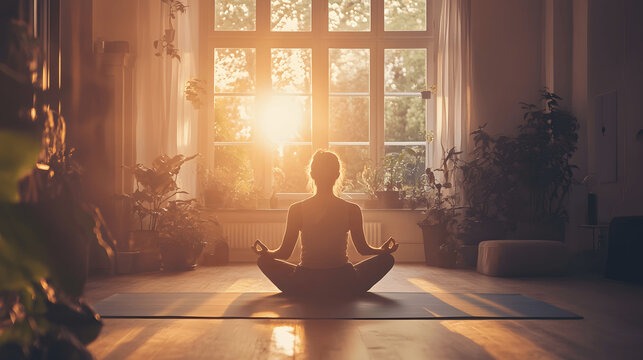Minimalism and mindfulness are friends sometimes who go on a date too that is minimalism and mindfulness comes up with a life that as simple as you can, as purpose as you can, as you want to, as best that you can. Minimalist living really boils down to the concept of deliberately simplifying your life by only truly appreciating what matters, and mindfulness will guide you through the process by staying present and aware of the moment.
Together, the magic that these two herbs bring combine to form a powerful synergy which allows you to not only declutter your physical space, but also declutter your mind and spirit.
In this article, we will discuss the role of mindfulness plays in minimalist living: what it is, how it can benefit you, actionable tips to enhance it and how to combine the two practices to work in harmony with your life.
What is Minimalist Living?
Decluttering your home, or owning less — in fact, it’s much more than that. This is about aligning what you do with how you live your values including your environment, time and priorities. Minimalism does this by getting rid of the excess and keeping it simple — removing stress, saving money and creating room in your life for meaningful experiences.
But making the move to minimalism can be daunting if you’re not sure where to start. That’s where mindfulness is useful as a guide on the journey.
Understanding Mindfulness
Mindfulness means being fully present in the here and now, aware of what you’re thinking and feeling and where you are without judgement. Mindfulness has its roots in ancient traditions like Buddhism but it has taken on a life of its own thanks to its mental health benefits (for instance reducing your anxiety or increasing your focus) and its popularity.
Using mindfulness can mean intentional decision making (declaring if we are keeping something or putting it for now) and helps you stay grounded with decluttering. Instead of acting on impulse, mindfulness allows you to ask important questions like:
- Am I going to live forever?
- Is this what brings me joy or makes sense?
- Is this childish hold a story of sentiment or a story of fear?
Mindfulness fosters self awareness which allows you to make mindful choice about every action you take as a minimalist.
The Connection Between Mindfulness and Minimalism
The matter of the relationship between mindfulness and minimalism is thoroughly connected. Here’s how mindfulness enhances minimalist living:
1. Intentional Living
Intentionality is the foundation of minimalism, and mindfulness helps you make your intention clear. By practicing mindfulness, you become more comfortable being aware of what you need and want, which helps determine what you want to keep and what you need to let go of.
2. Reducing Impulsive Behavior
Mindfulness makes you pause and reflect before purchasing new items or holding onto extra items you don’t need. It discourages impulsive behavior and channels a get conscious regarding consumption.
3. Cultivating Gratitude
Mindfulness moves you away from more, to more, and for what you already have, creating gratitude. Minimalism is about minimalism, quality over quantity, this mindset perfectly matches.
4. Emotional Decluttering
While the concept of minimalism is somewhat associated with people’s physical spaces, minimalism isn’t only about physical decluttering, but it’s also about taking your mental and emotional decluttering to the next level. Sitting in continual mindfulness allows you take a breath, process what you’re feeling without, and then letting go of past attachments so you can make space for inner peace.
Why Combining Mindfulness and Minimalism is so beneficial?
When you integrate mindfulness into your minimalist lifestyle, you unlock a host of benefits:
1. Enhanced Clarity
Apart from reducing distractions and focus on priority, mindfulness allows you to know what really counts so that you continue achieving.
2. Stress Reduction
Equally, a clutter free environment and a mindful state of mind go hand in hand with lowering stress an helping increase calm.
3. Improved Decision-Making
With mindfulness you are sharpening your decision making skills so that your choices do align with your values and your goals.
4. Increased Joy and Fulfillment
Appreciating the present while releasing what doesn’t serve anymore grants us space in the moment to feel joy and fulfilled in each day.
Mindful Minimalist Living: Practical Tips for Living Life this Way
Here are actionable steps to incorporate the role of mindfulness on minimalist lifestyle:
1. Start Small
One area of your life to focus on first would be your wardrobe or workspace. Decluttering can be practiced through mindfulness – observing your thoughts and feelings as you go about it. Try not to focus on the stuff that doesn’t serve a purpose or that isn’t joyful anymore.
2. Practice Mindful Consumption
Before making a purchase, ask yourself:
Do I really need this?
- What would this item do for me that I couldn’t already do for myself?
- Is this something I’m purchasing on need or inclination?
This practice stops you from buying impulsively and you don’t end up with the extra clutter.
3. Use Daily mindfulness rituals.
Incorporate mindfulness into your daily routine with simple practices like:
Meditation:
Take 5-10 minutes each day spending some focused time on your breath.
Journaling:
Consider your minimalist journey and record what you are intending in writing.
Gratitude Practice:
Each day, write three things you are grateful for.
4. Declutter with Intention
When decluttering, use mindfulness to consciously take the decisions. Ask yourself if each of the items you hold align with your values and goals, then hold each item. Let go of anything you don’t want.
5. Embrace Digital Minimalism
You can apply mindfulness to your digital life too. A more focused and intentional experience isn’t just an online experience, it’s an experience without unwanted emails, unused apps, and screen time restrictions.
6. Slow Down
Minimalism isn’t a race. Slowly and take your time to enjoy this process and to celebrate little victories. Mindfulness tells you to take it easy on yourself when your environment is changing.
How to overcome challenges
It doesn’t always come easy to practice mindful minimalist living. Here are common challenges and solutions:
1. Overwhelm
This can be discouraging if you’re overwhelmed by the amount of clutter. Do one small area at a time, even if it seems like an infinite mountain, but celebrate the progress.
2. Getting rid of Sentimental Items
It’s especially hard to let go of sentimental attachments. Just practice letting go of that memory and object together with gratitude.
3. Social Pressure
Success happens when we have material possessions in society. Remind yourself of the worth of minimalism, and your values.
Final Thoughts (Conclusion)
The key ingredient in minimalist living would be to cultivate mindfulness, which helps us to be intentional, clear, and resentful. These practices work together to lead you a life that is less complicated and more meaningful and fulfilling.
When you take mindfulness into your minimalist journey, it becomes much easier to release the unnecessary, appreciate the now, and live your life in the direction of the things that you Care about. But begin small, be consistent, and see the immense things mindful minimalism will change you.
Live a life of mindfulness in minimalist living and the joy of simplicity today.




Pingback: 10 Minimalist Apps to Simplify Your Life -
Pingback: How to Maintain a Minimalist Lifestyle Long Term -
Pingback: The Minimalist’s Guide to Mindful Shopping -
Thanks for sharing. I read many of your blog posts, cool, your blog is very good.
Thank you for your sharing. I am worried that I lack creative ideas. It is your article that makes me full of hope. Thank you. But, I have a question, can you help me?
Can you be more specific about the content of your article? After reading it, I still have some doubts. Hope you can help me.